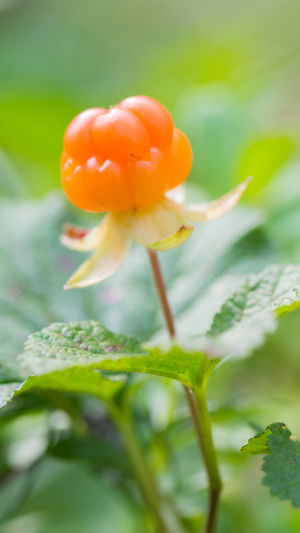Cloudberry, a perennial herb found in bogs, is a petite plant, standing between 10 to 25 centimeters tall.
The cloudberry's delicate, solitary flower boasts five white petals, and its blossoming moment occurs in June.
In the Arctic, where options for fresh fruits are scarce, cloudberries have long served as a vital source of vitamins for the indigenous Arctic populations.
Even in modern times, the people of the Nordic regions maintain a deep appreciation for the unique taste of cloudberries.
Their enthusiasm for these little gems continues undiminished, driving them to venture into the bogs during cloudberry season, often enduring days of hiking, rain boots, and the relentless buzzing of mosquitoes.
Fresh cloudberries and a selection of cloudberry products like jam, yogurt, and ice cream are readily available in supermarkets.
Much like strawberries, cloudberries sprawl close to the ground.
The cloudberry's fruit is edible, undergoing several color transformations as it matures. It starts as a soft yellow-green, transitions to reddish, and finally, ripens into a juicy, fragrant amber color.
This sweet and juicy berry can be enjoyed fresh, but it is also the star ingredient in preserves, jams, and vinegar.
Cloudberries thrive in shaded areas, favoring moist, neutral, and well-drained soil. They do not tolerate salt salinity or dry conditions. Instead, they flourish in boggy, wet meadow environments, embracing a pH range of 3.5 to 5.
They are highly adaptable to acidic, neutral, or acidic soils and can withstand extreme cold, even surviving temperatures as low as -40°C.
When cloudberries are ripe, they display a lovely golden-yellow hue and are delightfully soft and juicy. These little gems are a rich source of vitamin C and have a distinct tart flavor when enjoyed fresh.
If left to ripen further, they take on a creamy texture, reminiscent of yogurt, with a sweet flavor that's perfect for jams and juices.
Cloudberries are versatile; they can be transformed into jams, juices, berry soups, and a range of delectable desserts.
Their vibrant, eye-catching appearance also makes them an appealing addition to various dishes. If you wish to extend their shelf life, you can freeze them, juice them, or turn them into delicious jams.
The seeds of this remarkable berry are valuable not only for their flavor but also for their use in cosmetic production.
Cloudberries contain benzoic acid, enabling them to be preserved in juice and stored in cool conditions.
In the realm of vitamins, cloudberries truly shine. Just 75 grams of these berries can fulfill a person's daily vitamin C requirement.
Additionally, they contain higher amounts of vitamin E compared to many other fruits and grains. Among wild berries, cloudberries boast the highest fiber content.
The combination of their bright color and sweet-tart taste makes them a preferred choice as a side dish in gourmet dishes, and their precious seed oil finds its place in cosmetics production.





